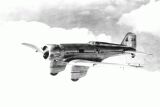
Gamma 2A "Sky Chief"
Photo: Northrop Grumman
|

Gamma 2A "Sky Chief"
and Frank Hawks
Note: "Park Bench" Ailerons
|
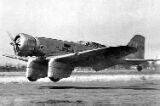
Northrop Gamma 2B: "Polar Star"
|

Northrop Gamma 2B "Polar Star"
Photo: Northrop Grumman
|

Northrop Gamma 2G
This was Jacqueline Cochran's plane
1934
|

Howard Hughes Record Flight
West to East Transcontinental: 9hr 26min
Gamma 2G at Floyd Bennett Field, July 1936
|

Hughes Record Flight
Gamma 2G at Floyd Bennett Field
|

Gamma 2H, 1938
|
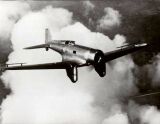
Gamma 1E, SE-ADW
Photo: Scandinavian Flight Operations
|
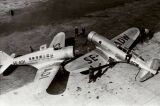
Delta 1C, SE-ADI,"Halland"
Gamma 1E, SE-ADW,"Småland"
Photo: Scandinavian Flight Operations
|

Gamma 2E
Photo: USAF
|

Chinese Gamma 2E
Photo: USAF
|

Chinese Gamma 2E
Photo: USAF
|
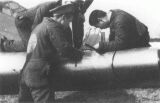
Chinese Gamma 2E - Servicing MG's
Photo: USAF
|

Northrop A-17
(Gamma 2F)
|
The Gamma family consisted of a number of variants. The Gamma family was an outgrowth of the Alpha, initially serving as a rugged civilian transport the Gamma eventually found it's way into military service with the US, Spain, China as war approached.
Model 2A, Qty 1: First Gamma delivered (1932). Purchased by Texico on February 14, 1933 for $40,000. Frank Hawks, the director of the Aviation department for the Texas Company used it for a number of record breaking flights. This aircraft was officially named "Texico 11" and commonly refered to as "Sky Chief". It was in this single seat model gamma that Hawks set a west to east nonstop record flying from Los Angeles to New York, in 13 hours, 26 minutes, 15 seconds (2 June 1933.)
Model 2B, Qty 1: Delivered to Lincoln Ellsworth who named it 'the polar star.' Ellsworth took the airplane to Antartica aboard a ship in 1934 with the famous aviator Bernt Balchen as his pilot. Ellsworth had planned a round trip flight between the bay of whales and the weddell sea. However, while still preparing for the flight the ice beneath the polar star broke apart and it was nearly lost. After considerable effort the plane was recovered and loaded back aboard a ship and then subsequently returned to America for repairs. Ellsworth and the Polar Star returned to Antartica in September, however before a flight could be made the plane broke a connecting rod and had to be shipped off once again for repairs. Finally, after returning once again to Antartica and finding an adequate runway the plane flew over Antartica on January 3, 1935. The following November Ellsworth and canadian pilot Herbert Hollick-Kenyon succeeded in flying the Polar Star across Antartica, becoming the first men to visit western Antartica. The Polar Star made a number of landings on it's journey across Antartica before it was forced down by fuel starvation just 25 miles short of it's transantartic goal. Over 2400 miles had been flown before the aircraft was forced down. The crew abandoned the aircraft and walked the remaining 25 miles to their destination, taking 6 days to arrive. The aircraft was later recovered and donated to the Smithsonian where it is currently on display.
Model 2C (Army YA-13, XA-16), Qty 1: Built in May 1933, this aircraft was evaluated as an attack bomber in August. Armament consisted of 4 wing-mounted .30 guns, one rear .30 cal gun with provisions for a 1,100 lb bomb under the fuselage.
Model 2D, Qty 3: Sold to TWA in 1934 for use as single seat mail planes. One of which (s/n 9) was licensed to test wing and propeller de-icers, radio, gasoline analyzers and a GE turbo-supercharger. Used as an "Experimental Overweather Laboratory", studies of icing, engine efficienty, radio performance and turbulence were carried out between 20,000 and 35,000 ft. Another aircraft after it's TWA service was used in coastal defense patrols for the Spanish Republican air force.
Model 2E, Qty 1: Sold to the UK for use by the Aeroplane & Armament Experimental Establishment.
Model 2L, Qty 1: Sold to Bristol Aeroplane in the UK for use as an engine test bed.
Model 2E, Qty 24: Twenty-three were sold to China as light bombers. Armament: 1600 lb bombs, 4 forward firing 7.62 mm machine guns, 1 rearward firing 7.62 mm machine gun mounted in a rear cockpit. They were used as attack bombers by the Chinease air force from 1934 until 1938. One was used by Frank Hawks on a South American sales tour. Airplane returned to America where it was eventually sold to a trading company that in turn disassembled the aircraft and shipped it to Russia.
Model 2E, Qty 25: Assembled in China from components provided by Northrop.
Model 1E, Qty 1: This two place, tandem cockpit experimental ship was exported to Sweden where it was used as a night mail plane.
Model 2G, Qty 1: Built as a 2-place gamma with a Curtiss Conqueror. Jacqueline Cochran ordered this aircraft with the intent to enter it in the MacRobertson Race although it was not entered. The powerplant was replaced with a P&W Twin Wasp Jr and Cochran entered it in the 1935 Bendix. Cochran leased the aircraft to Howard Hughes in 1935. Hughes had 3 new fuel tanks and a Wright Cyclone SGR-1820-G-5 installed and set a west to east transcontinental speed record of 9 hours, 26 minutes, 10 seconds.
Model 2H (2D2), Qty 1: Purchased in December 1934 and licensed experimental in January for testing the Sperry automatic pilot. Russell Thaw flew this aircraft to 3rd place in the 1935 Bendix. It was wrecked after an engine failure and rebuilt at the Northrop factory.
Model 5A (Japanese designation BXN1), Qty 1: Sold to the Japanese Navy and exported prior to 10-29-1935. Used for "a study of modern aviation engineering."
Model 5D (Japanese designation BXN2), Qty 1: Exported to Japan. Tail surfaces and interior were "Army type". After navy flight testing the aircraft was handed over to Nakajima Aircraft for study. Passed on to Manchurian Air Lines which used it for aerial reconnaissance above China and Russia through 1939.
Model 5B, Qty 1: A two place tandem aircraft with sliding cockpits located on the forward fuselage and a thined down aft fuselage. Eventually purchased by the Spanish Republican air force and used for coastal partrols.
Model 2F (A-17A and A-17AS), Qty 102: A derivative of the A-17 (Gamma 2C), the A-17A was equipped with retractable landing gear and dive flaps. One hundred A-17A aircraft were produced and delivered in 1936 and 37. Most were turned over to the Royal Air Force in 1940. Two unarmed 3-seat command transports designated A-17AS were delivered on of which was used by Maj Gen Westover, Chief of the USAAC. The second A-17AS was the personal aircraft of the assistant chief, Brig Gen H "Hap" Arnold.
Performance
Gamma 2A
Length: 30 ft
Wingspan: 48 ft
Wing Area: 363 sq ft
Empty Weight: 3,300 lb
Gross Weight: 7,100 lb
Powerplant: Wright Whirlwind GR-1510 (700 hp)
Top Speed: 200 mph
Gamma 2B
Length: 29 ft 9 in
Wingspan: 48 ft
Wing Area: 363 sq ft
Empty Weight: 3,200 lb (3,400 lb with floats)
Gross Weight: 7,100 lb
Powerplant: Pratt and Whitney Wasp (500 hp)
Top Speed: 180 mph
Gamma 2D
Length: 31 ft 2 in
Wingspan: 47 ft 10 in
Wing Area: 363 sq ft
Empty Weight: 4,119 lb (3,400 lb with floats)
Gross Weight: 7,350 lb
Powerplant: Wright Cyclone (710 hp)
Top Speed: 224 mph
Northrop Gamma Links














